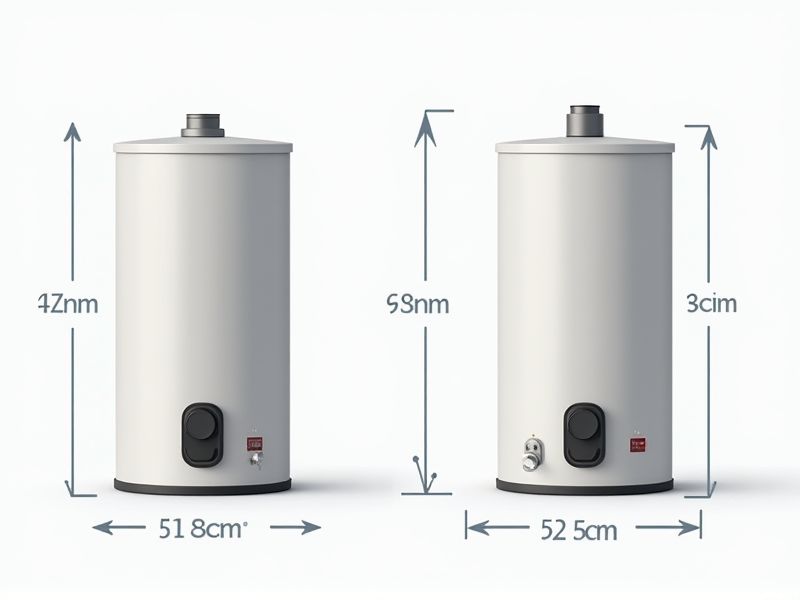
Hot water heaters are commonly available in a variety of standard dimensions, which helps with fitting them into most homes and utility spaces. A typical 40-gallon electric water heater, for example, usually stands around 48 to 60 inches tall and has a diameter of 18 to 22 inches. Compact or tankless models will often be much smaller and wall-mounted, making them ideal for tight spaces. Whenever you're selecting a water heater, it's important to measure your available space first and compare it to the manufacturer's sizing chart to ensure a proper fit.
Storage Tank Capacity
When selecting a hot water heater, the storage tank capacity is a critical factor to consider. Commonly available sizes range from 20 to 80 gallons, with 40 gallons being ideal for a household of 3-4 people. For instance, a larger family might require a unit with 50 gallons or more to ensure an adequate supply of hot water for daily needs like showers, dishwashing, and laundry. Understanding your household's specific hot water demand can help you choose an efficient solution that minimizes energy consumption and enhances convenience.
Heater Height
The standard height for residential hot water heaters typically ranges from 48 to 60 inches, with 50 gallons being the most common capacity. A heater's height can significantly influence installation options, especially in spaces with limited ceiling clearance. The dimensions can affect the unit's efficiency and maintenance accessibility, so it's crucial to choose a model that fits your specific requirements. You should measure your area's height to ensure proper installation without obstructing ventilation or safety features.
Heater Diameter
The standard diameter of a hot water heater typically ranges from 18 to 30 inches, depending on the model and capacity. For example, a 50-gallon tank usually has a diameter of approximately 24 inches. This measurement is crucial for ensuring that the heater fits comfortably in your designated space, such as a basement or utility room. When selecting a hot water heater, consider both the diameter and the available installation area to optimize performance and accessibility.
Recovery Rate
Hot water heaters are primarily evaluated based on their recovery rate, which is the amount of hot water the unit can produce in an hour. For example, a traditional tank water heater typically has a recovery rate between 20 to 40 gallons per hour, depending on the heater's size and fuel type. In contrast, tankless water heaters can provide an on-demand supply, offering anywhere from 3 to 7 gallons per minute, which equates to over 180 gallons per hour in some models. When considering a hot water heater, assessing the recovery rate ensures that your household's peak hot water demands are adequately met.
Water Connection Size
A hot water heater typically features a water connection size of 3/4 inch, which is standard for most residential systems. This size allows for efficient water flow, accommodating the average household demand of approximately 40 to 50 gallons of hot water per hour. It's essential to consider that using a connection size smaller than 3/4 inch may lead to reduced water pressure and longer wait times for hot water. When upgrading or installing a hot water heater, ensure your plumbing fits this essential specification for optimal performance.
Venting Requirements
Hot water heaters require proper venting to ensure safe and efficient operation. The venting system must comply with local building codes and the manufacturer's specifications, which typically call for a minimum vent diameter of 3 inches for gas-fired units. Proper vent installation is crucial, as it allows for the efficient expulsion of harmful gases, with a recommended height clearance of at least 12 inches above the roofline to prevent backdraft. Ensuring that your venting system is free of blockages and leaks is essential for maintaining a safe environment in your home.
Installation Space
When choosing a hot water heater, consider the installation space, which typically requires a minimum clearance of 12 inches from walls and ceilings for optimal ventilation. Standard sizes vary, but most residential units range from 30 to 80 gallons, ensuring adequate supply for your household's needs. The height and width of your chosen model should align with your available space, often between 48 to 60 inches tall and 18 to 30 inches wide. Ensuring proper measurements can prevent costly modifications and ensure efficient functionality.
Power Source Specifications
Hot water heaters typically operate using three main power sources: electricity, natural gas, or propane. Electric models are often rated between 3,000 to 5,500 watts, providing efficient heating for residential use. Natural gas heaters frequently deliver higher energy outputs, ranging from 30,000 to 40,000 BTUs, making them ideal for larger households with higher hot water demands. When selecting a water heater, consider your location, utility costs, and your household's hot water needs to ensure optimal performance and efficiency.
Thermal Insulation Thickness
The standard thermal insulation thickness for hot water heaters typically ranges from 1 to 3 inches, significantly influencing energy efficiency. With proper insulation, heat loss can be reduced by 25% to 45%, contributing to lower energy bills. Regulations often mandate a minimum insulation R-value of 12 for electric units and 16 for gas units, ensuring optimal performance. Upgrading to a model that meets or exceeds these insulation standards can improve your home's overall energy efficiency.
Weight Of The Unit
The standard weight of a hot water heater typically ranges from 80 to 150 pounds, with larger units exceeding 200 pounds. This weight considers factors such as the water tank capacity, which generally varies from 30 to 80 gallons. A heavier unit may indicate more insulation or a larger tank, potentially enhancing energy efficiency. When selecting a hot water heater, ensure that your installation area can support the unit's weight, as well as any potential water weight when full.
